Stimulus-frequency otoacoustic emission suppression tuning in humans: comparison to behavioral tuning
- PMID: 24013802
- PMCID: PMC3825025
- DOI: 10.1007/s10162-013-0412-1
Stimulus-frequency otoacoustic emission suppression tuning in humans: comparison to behavioral tuning
Abstract
As shown by the work of Kemp and Chum in 1980, stimulus-frequency otoacoustic emission suppression tuning curves (SFOAE STCs) have potential to objectively estimate behaviorally measured tuning curves. To date, this potential has not been tested. This study aims to do so by comparing SFOAE STCs and behavioral measures of tuning (simultaneous masking psychophysical tuning curves, PTCs) in 10 normal-hearing listeners for frequency ranges centered around 1,000 and 4,000 Hz at low probe levels. Additionally, SFOAE STCs were collected for varying conditions (probe level and suppression criterion) to identify the optimal parameters for comparison with behavioral data and to evaluate how these conditions affect the features of SFOAE STCs. SFOAE STCs qualitatively resembled PTCs: they demonstrated band-pass characteristics and asymmetric shapes with steeper high-frequency sides than low, but unlike PTCs they were consistently tuned to frequencies just above the probe frequency. When averaged across subjects the shapes of SFOAE STCs and PTCs showed agreement for most recording conditions, suggesting that PTCs are predominantly shaped by the frequency-selective filtering and suppressive effects of the cochlea. Individual SFOAE STCs often demonstrated irregular shapes (e.g., "double-tips"), particularly for the 1,000-Hz probe, which were not observed for the same subject's PTC. These results show the limited utility of SFOAE STCs to assess tuning in an individual. The irregularly shaped SFOAE STCs may be attributed to contributions from SFOAE sources distributed over a region of the basilar membrane extending beyond the probe characteristic place, as suggested by a repeatable pattern of SFOAE residual phase shifts observed in individual data.
Figures
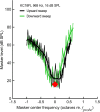




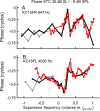



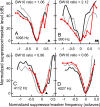
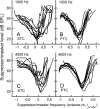

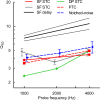
References
-
- Abdala C, Fitzgerald TS. Ipsilateral distortion product otoacoustic emission (2f1-f2) suppression in children with sensorineural hearing loss. J Acoust Soc Am. 2003;114:919–931. - PubMed
-
- Al'tman YA, Nikitin NI. Properties of derived cochlear action potentials in forward tonal masking in guinea pigs. Neurosci Behav Physiol. 2000;30:587–598. - PubMed
-
- Bargones JY, Burns EM. Suppression tuning curves for spontaneous otoacoustic emissions in infants and adults. J Acoust Soc Am. 1988;83:1809–1816. - PubMed
-
- Bentsen T, Harte JM, Dau T. Human cochlear tuning estimates from stimulus-frequency otoacoustic emissions. J Acoust Soc Am. 2011;129:3797–3807. - PubMed
-
- Brass D, Kemp DT. Suppression of stimulus frequency otoacoustic emissions. J Acoust Soc Am. 1993;93:920–939. - PubMed
Publication types
MeSH terms
Grants and funding
LinkOut - more resources
Full Text Sources
Other Literature Sources
Research Materials

